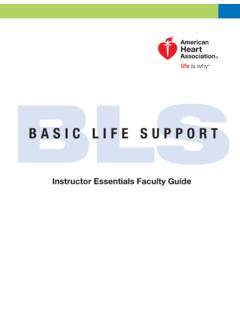Transcription of BLS Study Guide - ACLS123
1 12/12/12 CRITICAL CARE TRAINING CENTER | COPYRIGHT 2012 Course Overview This Study Guide is an outline of content that will be taught in the american Heart association Accredited basic life Support (BLS) Course. It is intended to summarize important content, but since all BLS content cannot possibly be absorbed in a class given every two years, it is expected that the student will have the 2010 Updated ECC Handbook readily available for review as a reference. The student is also required to have the AHA BLS Textbook available for reference and Study for more in depth content.
2 Evidence Based Updates Approximately every 5 years the AHA updates the guidelines for CPR and Emergency Cardiovascular Care. These updates are necessary to ensure that all AHA courses contain the best information and recommendations that can be supported by current scientific evidence experts from outside the United States and outside the AHA. The guidelines were then classified as to the strength of evidence that supports the recommendation. 2010 AHA Guidelines for CPR and ECC Science Update The 2010 american Heart association Guidelines for Cardiopulmonary Resuscitation and Emergency Cardiovascular Care recommendations for healthcare providers include the following key changes and issues.
3 Changes in basic life support (BLS sequence) Continued emphasis on high- quality CPR, with minor changes in compression rate and depth Additional changes regarding cricoid pressure, pulse check and AED use in infants Critical Concepts High- quality CPR improves a victim s chances of survival. The critical characteristics of high- quality CPR include. Start Compressions within 10 seconds Push Hard, Push Fast Allow complete Chest recoil Minimize interruptions Give effective Breaths Avoid Excessive Ventilations Changes in Sequence.
4 C- A- B NOT A- B- C In the A- B- C sequence, chest compressions were often delayed while the rescuer opened the airway to give mouth- to- mouth breaths, retrieved a barrier device, or gathered and assembled ventilation equipment. By changing the sequence to C- A- B, rescuers can start chest compressions sooner, and the delay in giving breaths should be minimal (only the tie required to deliver the first cycle of 30 chest compression, or approximately 18 seconds or less; for 2- rescuer infant or child CPR, the delay will be even shorter).
5 Emphasis on High- Quality CPR A compression rate of at least 100/min (this is a change from approximately 100/min) A compression depth of at least 2 inches (5cm) in adult and a compression depth of at least one third of the anterior- posterior diameter of the chest in infants and children. This is approximately 1 inches (4cm) in infants and 2 inches (5cm) in children.
6 Note that the range of 1 to 2 inches is no longer used for adults, and the absolute depth specified for children and infants is deeper than in previous versions of the AHA Guidelines for CPR and ECC. Allow complete chest recoil, minimizing interruptions in compressions, and avoiding excessive ventilation continues to be important components of high- quality CPR.
7 Continued de- emphasis of the pulse check It can be difficult to determine the presence or absence of pulse within 10 seconds, especially in an emergency, and studies show that both healthcare providers and lay rescuers are unable to reliably detect a pulse If a victim is unresponsive and not breathing or only gasping, healthcare providers may take up to 10 seconds to attempt to feel for a pulse (brachial in an infant and carotid or femoral in a child) If within 10 seconds you don t feel a pulse or are not sure if you feel a pulse, begin chest compressions.
8 The Routine use of cricoid pressure in cardiac arrest is not recommended It may block ventilation Delay the placement of an advance airway Difficult to train rescuers how to do this Use of an AED for infants For infants, a manual defibrillator is preferred to an AED for defibrillation. If a manual defibrillator is not available, an AED equipped with a pediatric dose attenuator is preferred If neither is available, you may use an AED without a pediatric dose attenuator Importance of a Firm Surface Compressions pump the blood in the heart to the rest of the body.
9 If a firm surface is under the victim, the force you use will be more likely to compress the chest and heart and create blood flow rather than simply push the victim into the mattress or other soft surface. BLS/CPR for Adults BLS Consist of these main parts Chest Compressions Airway Breathing Defibrillation Follow these initial BLS steps for adults 1.
10 Assess the victim for a response and look for normal or abnormal breathing. It there is no response and not breathing or no normal breathing ( , only gasping), shout for help. 2. If you are alone, activate the emergency response system and get an AED (or defibrillator) if available and return to the victim. 3. Check the victim s pulse (take at least 5 but no more than 10 seconds) 4.


